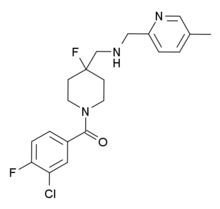Befiradol
Befiradol (F-13,640; NLX-112) is an experimental drug being studied for the treatment of levodopa-induced dyskinesia. It is a potent and selective 5-HT1A receptor full agonist.
 | |
| Clinical data | |
|---|---|
| ATC code |
|
| Legal status | |
| Legal status |
|
| Identifiers | |
IUPAC name
| |
| CAS Number | |
| PubChem CID | |
| IUPHAR/BPS | |
| ChemSpider | |
| UNII | |
| ChEMBL | |
| Chemical and physical data | |
| Formula | C20H22ClF2N3O |
| Molar mass | 393.86 g·mol−1 |
| 3D model (JSmol) | |
SMILES
| |
InChI
| |
| | |
Pharmacology
In recombinant cell lines expressing human 5-HT1A receptors, befiradol exhibits high agonist efficacy for a variety of signal transduction read-outs, including ERK phosphorylation, G-protein activation, receptor internalization and adenylyl cyclase inhibition.[1] In rat hippocampal membranes it preferentially activates GalphaO proteins.[1] In neurochemical experiments, befiradol activated 5-HT1A autoreceptors in rat dorsal Raphe nucleus as well as 5-HT1A heteroreceptors on pyramidal neurons in the frontal cortex.[2] It has powerful analgesic and antiallodynic effects comparable to those of high doses of opioid painkillers, but with fewer and less prominent side effects, as well as little or no development of tolerance with repeated use.[3][4][5][6][7]
A structure-activity relationships (SAR) study revealed that replacement of the dihalophenyl moiety by 3-benzothienyl increases maximal efficacy from 84% to 124% (Ki=2.7 nM).[8][9]
History
Befiradol was discovered and developed by Pierre Fabre Médicament, a French pharmaceuticals company. In September 2013, befiradol was out-licensed to Neurolixis, a California-based biotechnology company. Neurolixis announced that it intends to re-purpose befiradol for the treatment of levodopa-induced dyskinesia in Parkinson's disease.[10] In support of this indication, Neurolixis received several research grants[11] from the Michael J. Fox Foundation and preclinical data was published describing the activity of befiradol in animal models of Parkinson's disease.[12][13] In January 2018, the British charity Parkinson's UK announced that it had awarded Neurolixis a grant to advance development of befiradol up to clinical phase in Parkinson's disease patients.[14]. In March 2019, Neurolixis announced that the US Food and Drug Administration (FDA) gave a positive response to Neurolixis' Investigational New Drug (IND) application for NLX-112 to be tested in a Phase 2 clinical study in Parkinson's disease patients with troublesome levodopa-induced dyskinesia.[15]
See also
References
- Newman-Tancredi, Adrian; Martel, Jean-Claude; Cosi, Cristina; Heusler, Peter; Lestienne, Fabrice; Varney, Mark A.; Cussac, Didier (2017-06-14). "Distinctive in vitro signal transduction profile of NLX-112, a potent and efficacious serotonin 5-HT1A receptor agonist". The Journal of Pharmacy and Pharmacology. 69 (9): 1178–1190. doi:10.1111/jphp.12762. ISSN 2042-7158. PMID 28612503.
- Lladó-Pelfort, Laia; Assié, Marie-Bernadette; Newman-Tancredi, Adrian; Artigas, Francesc; Celada, Pau (May 2012). "In vivo electrophysiological and neurochemical effects of the selective 5-HT1A receptor agonist, F13640, at pre- and postsynaptic 5-HT1A receptors in the rat". Psychopharmacology. 221 (2): 261–272. doi:10.1007/s00213-011-2569-9. ISSN 1432-2072. PMID 22147258.
- Bardin L, Tarayre JP, Malfetes N, Koek W, Colpaert FC (April 2003). "Profound, non-opioid analgesia produced by the high-efficacy 5-HT(1A) agonist F 13640 in the formalin model of tonic nociceptive pain". Pharmacology. 67 (4): 182–94. doi:10.1159/000068404. PMID 12595749.
- Bruins Slot LA, Koek W, Tarayre JP, Colpaert FC (April 2003). "Tolerance and inverse tolerance to the hyperalgesic and analgesic actions, respectively, of the novel analgesic, F 13640". European Journal of Pharmacology. 466 (3): 271–9. doi:10.1016/S0014-2999(03)01566-8. PMID 12694810.
- Bardin L, Assié MB, Pélissou M, Royer-Urios I, Newman-Tancredi A, Ribet JP, Sautel F, Koek W, Colpaert FC (March 2005). "Dual, hyperalgesic, and analgesic effects of the high-efficacy 5-hydroxytryptamine 1A (5-HT1A) agonist F 13640 [(3-chloro-4-fluoro-phenyl)-[4-fluoro-4-{[(5-methyl-pyridin-2-ylmethyl)-amino]-methyl}piperidin-1-yl]methanone, fumaric acid salt]: relationship with 5-HT1A receptor occupancy and kinetic parameters". The Journal of Pharmacology and Experimental Therapeutics. 312 (3): 1034–42. doi:10.1124/jpet.104.077669. PMID 15528450.
- Colpaert FC, Deseure K, Stinus L, Adriaensen H (February 2006). "High-efficacy 5-hydroxytryptamine 1A receptor activation counteracts opioid hyperallodynia and affective conditioning". The Journal of Pharmacology and Experimental Therapeutics. 316 (2): 892–9. doi:10.1124/jpet.105.095109. PMID 16254131.
- Deseure K, Bréand S, Colpaert FC (July 2007). "Curative-like analgesia in a neuropathic pain model: parametric analysis of the dose and the duration of treatment with a high-efficacy 5-HT(1A) receptor agonist". European Journal of Pharmacology. 568 (1–3): 134–41. doi:10.1016/j.ejphar.2007.04.022. PMID 17512927.
- Bollinger S, Hübner H, Heinemann FW, Meyer K, Gmeiner P (October 2010). "Novel pyridylmethylamines as highly selective 5-HT(1A) superagonists". J. Med. Chem. 53 (19): 7167–79. doi:10.1021/jm100835q. PMID 20860381.
- Vacher B, Bonnaud B, Funes P, Jubault N, Koek W, Assié MB, Cosi C, Kleven M (May 1999). "Novel derivatives of 2-pyridinemethylamine as selective, potent, and orally active agonists at 5-HT1A receptors". J. Med. Chem. 42 (9): 1648–60. CiteSeerX 10.1.1.325.8872. doi:10.1021/jm9806906. PMID 10229633.
- http://neurolixis.com/images/stories/nlx_pf_license_23sept13.pdf
- "Parkinson's Disease Grants funded by the Michael J. Fox Foundation | Parkinson's Disease". The Michael J. Fox Foundation for Parkinson's Research | Parkinson's Disease. Retrieved 2017-06-23.
- Iderberg, H; McCreary, AC; Varney, MA; Kleven, MS; Koek, W; Bardin, L; Depoortère, R (September 2015). "NLX-112, a novel 5-HT1A receptor agonist for the treatment of L-DOPA-induced dyskinesia: Behavioral and neurochemical profile in rat". Exp Neurol. 271: 335–50. doi:10.1016/j.expneurol.2015.05.021. PMID 26037043.
- McCreary, AC; Varney, MA; Newman-Tancredi, A (January 2016). "The novel 5-HT1A receptor agonist, NLX-112 reduces l-DOPA-induced abnormal involuntary movements in rat: A chronic administration study with microdialysis measurements". Neuropharmacology. 105: 651–60. doi:10.1016/j.neuropharm.2016.01.013. PMID 26777281.
- https://www.parkinsons.org.uk/news/investing-new-treatment-dyskinesia
- https://www.prlog.org/12758787-fda-approves-neurolixis-ind-application-for-clinical-trial-with-nlx-112-in-parkinsons-disease.html